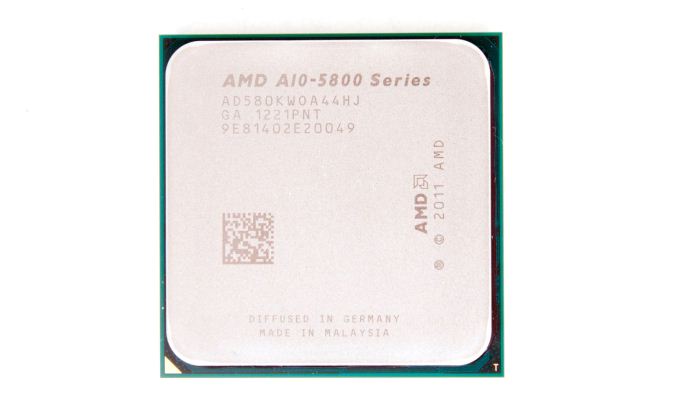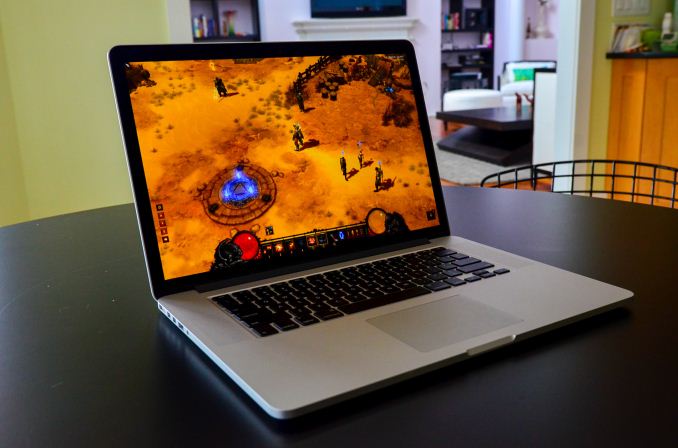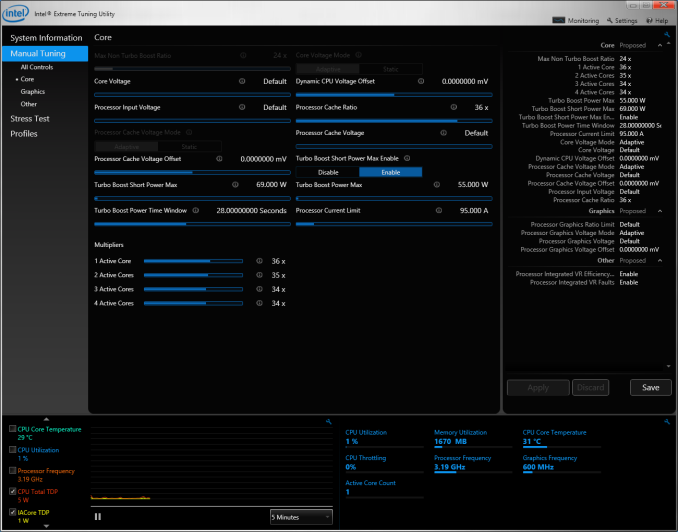Intel Iris Pro 5200 Graphics Review: Core i7-4950HQ Tested
by Anand Lal Shimpi on June 1, 2013 10:01 AM ESTThe Comparison Points
Intel sort of dropped this CRB off without anything to compare it to, so I scrambled over the past week looking for things to put Iris Pro’s performance in perspective. The obvious candidate was Apple’s 15-inch MacBook Pro with Retina Display. I expect its successor will use Iris Pro 5200, making this a perfect comparison point. The 15-inch rMBP is equipped with a GeForce GT 650M with a 900MHz core clock and a 5GHz memory datarate.
I also dusted off a GeForce GT 640 desktop card to shed a little more light on the 650M comparison. The 640 has a slightly higher core clock (925MHz) but it only has 1.7GHz DDR3, working out to be 27GB/s of memory bandwidth compared to 83GB/s for the 650M. Seeing how Iris Pro compares to the GT 640 and 650M will tell us just how good of a job Crystalwell is doing.
Next up is the desktop Core i7-4770K with HD 4600 graphics. This is a Haswell GT2 implementation, but at a much higher TDP than the 47W mobile part we’re comparing it to (84W). In a notebook you can expect a much bigger gap in performance between the HD 4600 and Iris Pro than what we’re showing here. Similarly I also included a 77W HD 4000 for a comparison to Ivy Bridge graphics.
On the AMD front I have the 35W A10-4600M (codename Trinity), featuring AMD’s 7660G processor graphics. I also included the 100W A10-5800 as a reference point since we were largely pleased with the GPU performance of Trinity on the desktop.
I listed TDPs with all of the parts I’m comparing here. In the case of the GT 640 I’m adding the TDP of the CPU (84W) and the GPU (65W). TDP is half of the story with Iris Pro, because the CPU, GPU and eDRAM all fit into the same 47W power envelope. With a discrete GPU, like the 650M, you end up with an extra 45W on top of the CPU’s TDP. In reality the host CPU won’t be running at anywhere near its 45W max in that case, so the power savings are likely not as great as you’d expect but they’ll still be present.
At the request of at least one very eager OEM, Intel is offering a higher-TDP configuration of the i7-4950HQ. Using Intel’s Extreme Tuning Utility (XTU) I was able to simulate this cTDP up configuration by increasing the sustained power limit to 55W, and moving the short term turbo power limit up to 69W. OEMs moving from a 2-chip CPU + GPU solution down to a single Iris Pro are encouraged to do the same as their existing thermal solutions should be more than adequate to cool a 55W part. I strongly suspect this is the configuration we’ll see in the next-generation 15-inch MacBook Pro with Retina Display.
To remove as many bottlenecks as possible I configured all integrated GPU options (other than Iris Pro 5200) with the fastest supported memory. That worked out to being DDR3-2133 on desktop Trinity and desktop IVB, and DDR3-2400 on desktop Haswell (HD 4600). The mobile platforms, including Iris Pro 5200, all used DDR3-1600.
On the software side I used NVIDIA's GeForce R320 v320.18, AMD's Catalyst 13.6 beta and Intel's 9.18.10.3177 drivers with Crystalwell support.













177 Comments
View All Comments
Death666Angel - Tuesday, June 4, 2013 - link
"What Intel hopes however is that the power savings by going to a single 47W part will win over OEMs in the long run, after all, we are talking about notebooks here."This plus simpler board designs and fewer voltage regulators and less space used.
And I agree, I want this in a K-SKU.
Death666Angel - Tuesday, June 4, 2013 - link
And doesn't MacOS support Optimus?RE: "In our 15-inch MacBook Pro with Retina Display review we found that simply having the discrete GPU enabled could reduce web browsing battery life by ~25%."
GullLars - Tuesday, June 4, 2013 - link
Those are strong words in the end, but i agree Intel should make a K-series CPU with Crystalwell. What comes to mind is they may be doing that for Broadwell.The Iris Pro solution with eDRAM looks like a nice fit for what i want in my notebook upgrade coming this fall. I've been getting by on a Core2Duo laptop, and didn't go for Ivy Bridge because there were no good models with a 1920x1200 or 1920x1080 display without dedicated graphics. For a system that will not be used for gaming at all, but needs resolution for productivity, it wasn't worth it. I hope this will change with Haswell, and that i will be able to get a 15" laptop with >= 1200p without dedicated graphics. 4950HQ or 4850HQ seems like an ideal fit. I don't mind spending $1500-2000 for a high quality laptop :)
IntelUser2000 - Tuesday, June 4, 2013 - link
ANAND!!You got the FLOPs rating wrong on the Sandy Bridge parts. They are at 1/2 of Ivy Bridge.
1350MHz with 12 EUs and 8 FLOPs/EU will result in 129.6GFlops. While its true in very limited scenarios Sandy Bridge's iGPU can co-issue, its small enough to be non-existent. That is why a 6EU HD 2500 comes close to 12EU HD 3000.
Hrel - Tuesday, June 4, 2013 - link
If they use only the HD4600 and Iris Pro that'd probably be better. As long as it's clearly labeled on laptops. HD 4600 Pro (don't expect to do any video work on this) Iris Pro (it's passable in a pinch).But I don't think that's what's going to happen. Iris Pro could be great for Ultrabooks; I don't really see any use outside of that though. A low end GT740M is still a better option in any laptop that has the thermal room for it. Considering you can put those in 14" or larger ultrabooks I still think Intel's graphics aren't serious. Then you consider the lack of Compute, PhysX, Driver optimization, game specific tuning...
Good to see a hefty performance improvement. Still not good enough though. Also pretty upsetting to see how many graphics SKU's they've released. OEM'S are gonna screw people who don't know just to get the price down.
Hrel - Tuesday, June 4, 2013 - link
The SKU price is 500 DOLLARS!!!! They're charging you 200 bucks for a pretty shitty GPU. Intel's greed is so disgusting it over rides the engineering prowess of their employees. Truly disgusting Intel; to charge that much for that level of performance. AMD we need you!!!!xdesire - Tuesday, June 4, 2013 - link
May i ask a noob question? Question: Do we have no i5s, i7s WITHOUT on board graphics any more? As a gamer i'd prefer to have a CPU + discrete GPU in my gaming machine and i don't like to have extra stuff stuck on the CPU, lying there consuming power and having no use (for my part) whatsoever. No ivy bridge or haswell i5s, i7s without iGPU or whatever you call it?flyingpants1 - Friday, June 7, 2013 - link
They don't consume power while they're not in use.Hrel - Tuesday, June 4, 2013 - link
WHY THE HELL ARE THOSE SO EXPENSIVE!!!!! Holy SHIT! 500 dollars for a 4850HQ? They're charging you 200 dollars for a shitty GPU with no dedicated RAM at all! Just a cache! WTFF!!!Intel's greed is truly disgusting... even in the face of their engineering prowess.
MartenKL - Wednesday, June 5, 2013 - link
What I don't understand is why Intel didn't do a "next-gen console like processor". Like takeing the 4770R and doubling the GPU or een quadrupling, wasn't there space? The thermal headroom must have been there as we are used to CPUs with as high as 130W TDP. Anyhow, combining that with awesome drivers for Linux would have been a real competition to AMD/PS4/XONE for Valve/Steam. A complete system under 150w capable of awesome 1080p60 gaming.So now I am looking for the best performing GPU under 75W, ie no external power. Which is it, still the Radeon HD7750?